The question we’re all asking is, “How can we save children from gun violence?” Whether you’re pro-gun or pro-gun control, we can all agree that adolescent firearm deaths are tragic.
This is an important topic where terminology matters, as “adolescents” isn’t synonymous with children or teenagers. And the meme, “guns are the leading cause of death for children”, is popular but wrong as we detail below.
Report Highlights:
-
According to the most recent available data, there were 10,048 injury-related deaths (individuals between the ages <1-17). 2,590 of those deaths involved firearms.
-
62% of child injury-related deaths included mechanisms other than firearms.
-
Firearms accounted for less than 25% of all injury-related juvenile deaths.
-
1,590 adolescents nationwide committed suicide. Of those, 790 suicides involved firearms.
-
There were 2,220 homicides among the <1-17 age group. Firearms were suspected in 1,503 of those homicides.
-
There were 161 more adolescent homicides (all methods) compared to the previous year.
-
There were 93 school shootings. Of those, 7 adolescents were killed inside the school during school hours.
It should be emphasized that it is illegal for an individual <1-17 to possess a handgun in 49 states, however, 30 states allow minors to possess long guns for hunting and recreational activities with parental consent. That being said, rifles and shotguns were used in 4% of all homicides in all age groups in 2021.
Key Methodology & Terminology Relating to Adolescents & Firearms
It is important to note the key methodology used to evaluate and define the terminology when discussing adolescents and firearms. The adolescent age group is often defined as ages <1-17, <1-19, and <1-24. The following research focuses on ages <1-17. Firearm-related deaths include injuries resulting from firearms. This includes suicide, homicide, unintentional deaths, legal intervention, and undetermined deaths. School shootings include all firearm-related incidents and school property. Including bullets fired off campus.
Firearm-Related Homicides & Adolescents
- 17-year-olds account for the majority of all adolescent homicides with 541 total in 2021 and 514 were firearm-related.
- 16-year-olds account for the second-highest amount of homicides in 2021. There were 358 firearm-related homicides of 382 total.
- 551 of 2,220 homicides were non-firearm-related deaths in 2021.
- There were 2,220 adolescent homicides in 2021:
- 1,001 Black American juveniles and 380 White American juveniles were murdered with a firearm.
- 60% of all adolescent firearm-related homicides were black youth and 23% of all firearm-related youth homicides were white.
- 930 individuals under the age of 18 were arrested for homicide in 2020 – 58% of all juveniles arrested for homicide in 2020 were black and 40% were white.
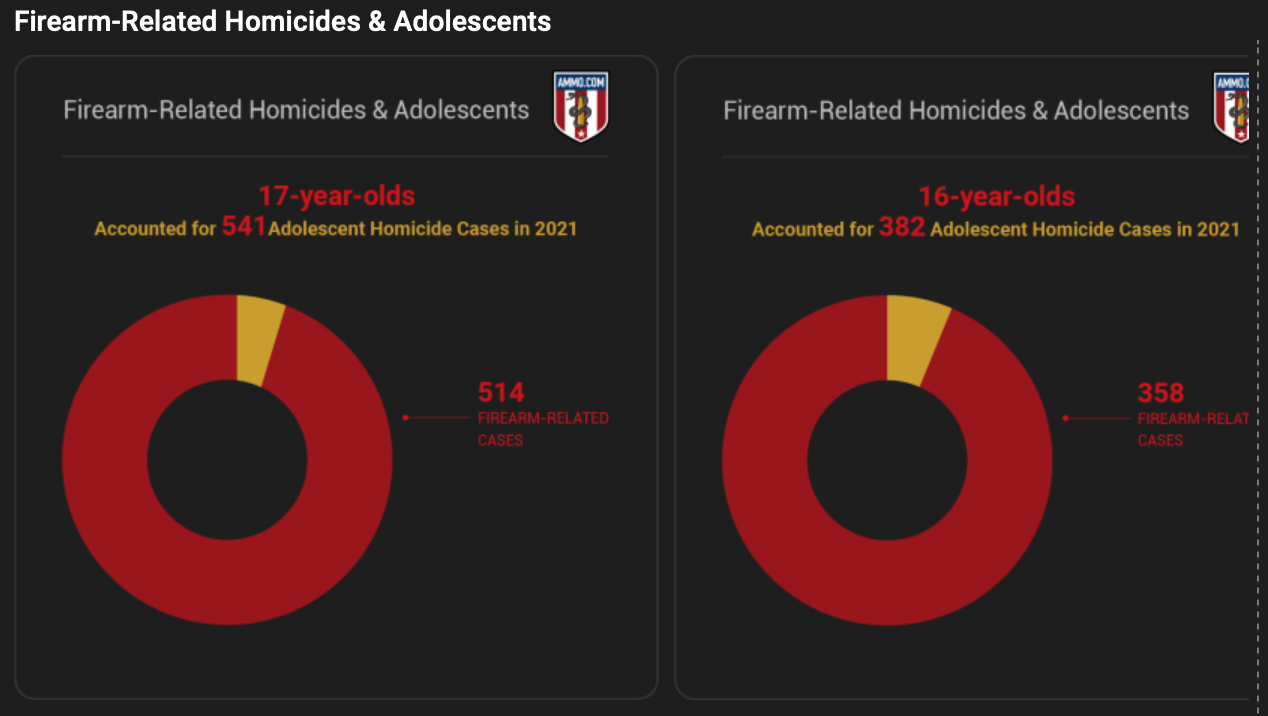
Firearm-Related Suicides & Adolescents
- Adolescent suicide deaths also increased by 62% in a ten-year period from 2010-2020.
- In 2021, 733 children died of suffocation-related suicides. 795 children died of firearm-related suicides. A total of 1,590 children (ages <1-17) committed suicide.
- Children between the ages 10-14 were more likely to die from suffocation-related suicide (53.7%) than firearms (38.6%).
- In 2020, 1,516 children committed suicide with 687 firearm-related deaths.
- 2018 saw a higher number of adolescent suicides with 1,680 total, but only 696 firearm-related.
The question we’re all asking is, “How can we save children from gun violence?” Whether you’re pro-gun or pro-gun control, we can all agree that adolescent firearm deaths are tragic; no child should succumb to an untimely end, especially because injury-related deaths are often entirely avoidable.
While we don’t have all the answers to stop adolescent firearm deaths, we can shed some light on the reality of what America’s youth are facing today. For example, the older a child gets, the more likely they are to participate in high-risk lifestyles, and therefore become a homicide statistic. There were a total of 2,220 adolescent homicides in 2021 (all methods).
In 2021, the vast majority of adolescent homicides occurred in the seventeen-year age group (541 seventeen-year-olds were murdered in 2021, with 514 of those murdered with a firearm). Next, 16-year-olds accounted for 382 homicides in the adolescent group with 358 firearm-related deaths.
While children aren’t always the perpetrators in these horrific homicides, there were 930 individuals under the age of 18 arrested for homicide in 2020.
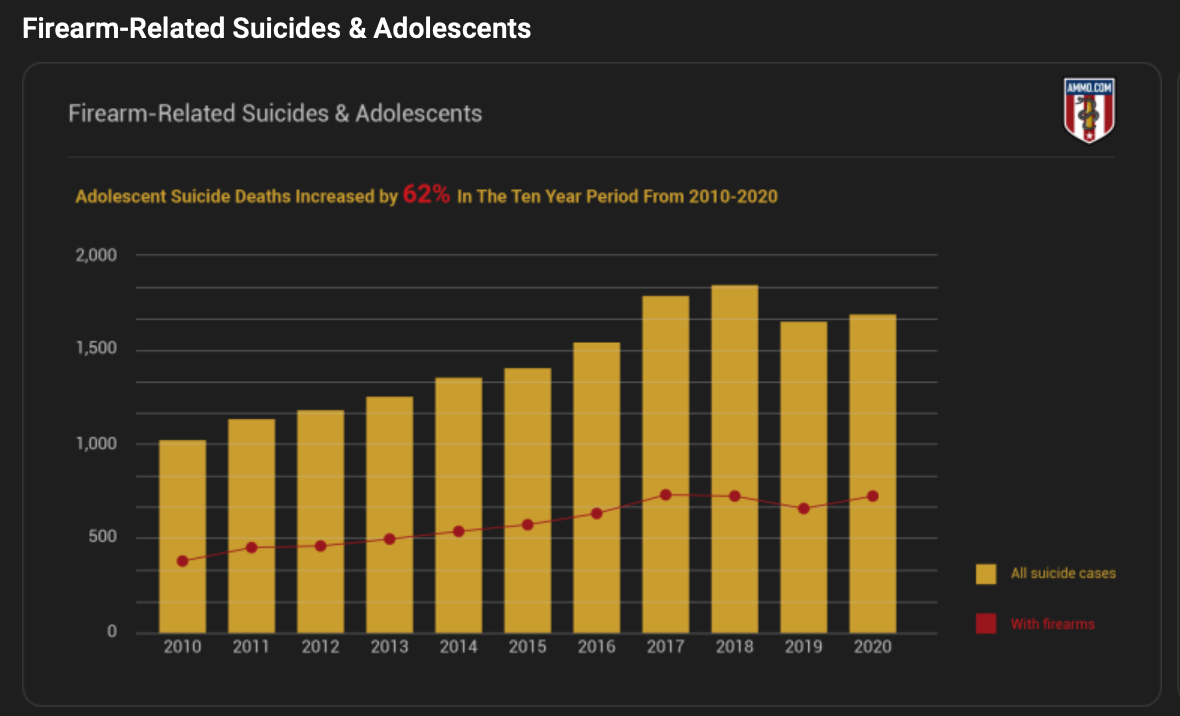
Unintentional Firearm-Related Deaths & Adolescents
- An estimated 4.6 million homes have children and loaded unlocked firearms. There were 48 unintentional juvenile firearm-related deaths in 2021 (.00001% of adolescents with access to a firearm in the home).
- There were 5,746 total unintentional deaths in 2020. 21 of those were firearms-related.
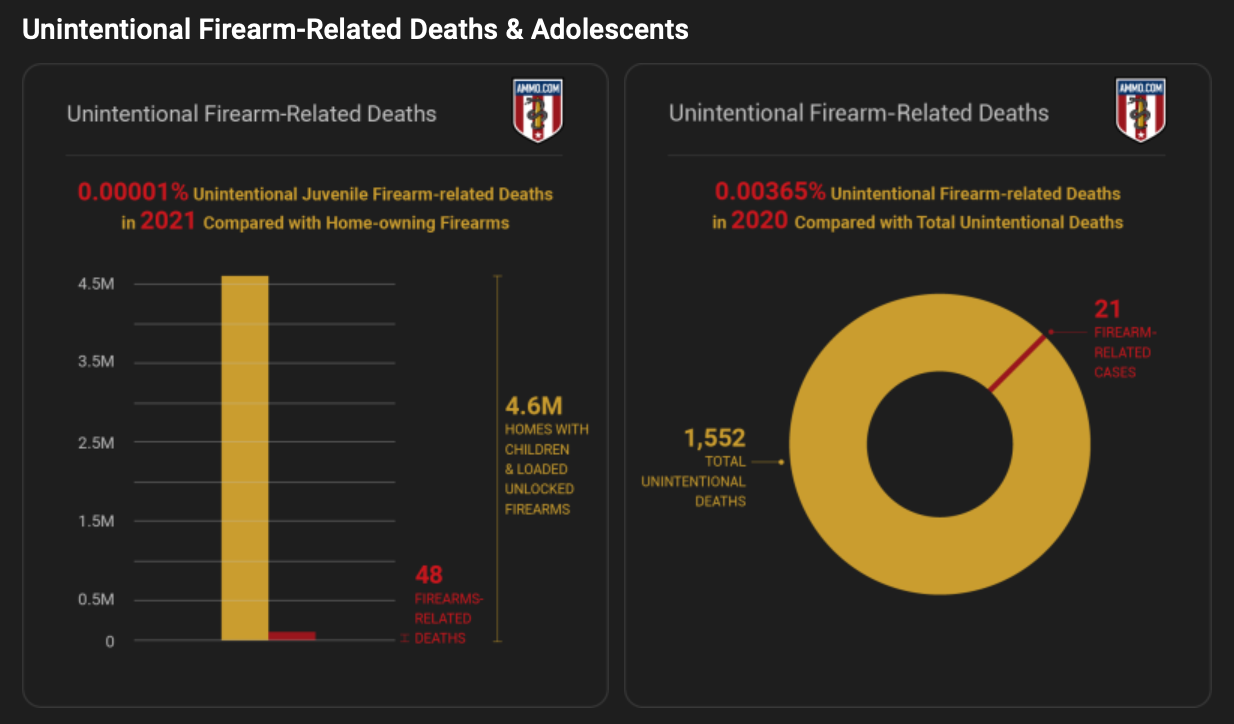
Adolescent Firearm-Related Deaths – Wrap Up
- In 2021, there were 2,590 firearm-related deaths between the ages of <1-17, compared to 2,758 vehicle-related deaths (including pedestrian and all automobile-related injuries).
- Of the 2,220 adolescent homicides in 2021, 1,552 were firearms-related (<1-17 years of age).
- The age group included 1,590 suicides in 2021, with 795 involving firearms compared to 1,679 suicides in 2020 with 721 involving firearms.
- There were 8,818 Assault By Other Firearm Discharges between 2018-2021. Of those assaults, 4,626 were adults between 18-19 years old.
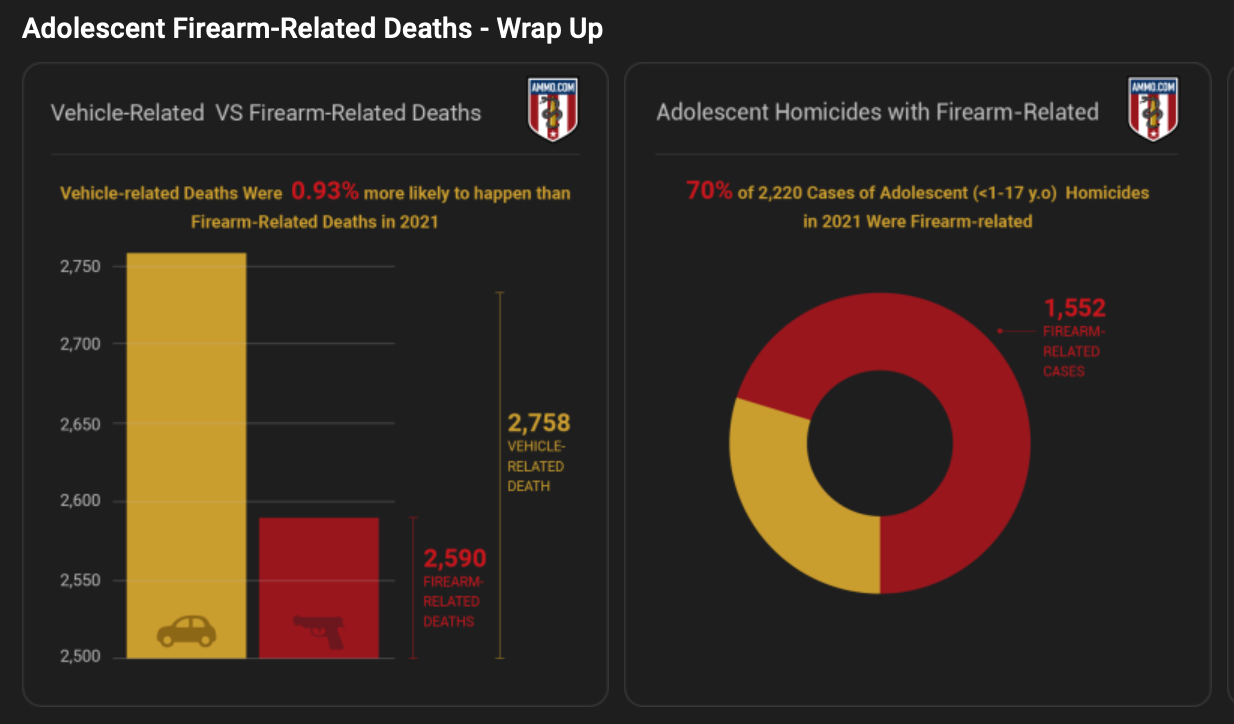
Adolescent Homicide Offenders
- The highest year for juvenile homicide offenders with firearms was 1994 with 2,271 arrests (during the Assault Weapon ban). The lowest year in two decades was 2014 with 498 juvenile offenders.
- It is illegal in all 50 states for a minor to possess a concealed firearm outside of hunting or recreational activities and/or without custodial consent.
- Juveniles committed 11,792 firearm-related homicides during the 1994-2004 Assault weapons ban. The rate remained the same in the decade after the Assault Weapons ban with 11,796 arrested for firearm-related homicides (2005-2023). Source
- 75% of all juvenile offenders were between the ages of 16 and 17 (2020). Source
- 42.6% of all juvenile homicides were crimes that involved an adult and juvenile offender (2020). Source
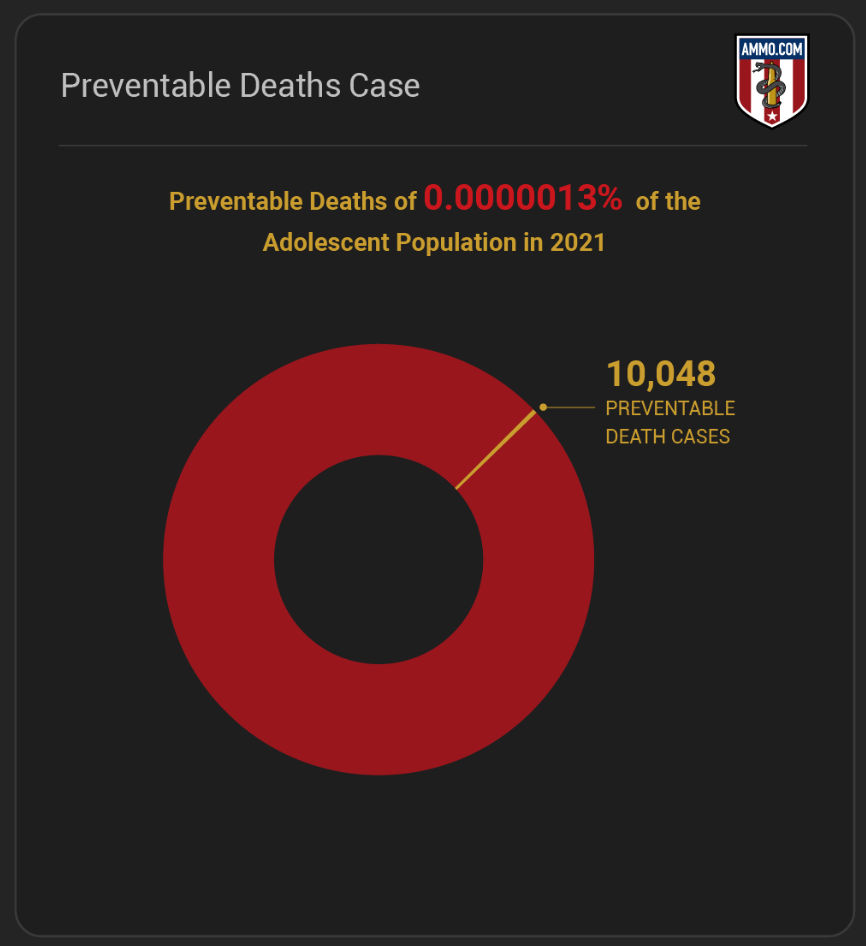
Preventable Deaths Case; graphic by author.
One burning question that must be addressed is, “How does gun control legislation affect adolescents?” Unfortunately, one of the most sweeping federal laws restricting firearm access did relatively little to keep adolescents from obtaining and using firearms.
More than 11,000 juveniles were arrested during the time period when the 1994 Assault Weapons ban. Similarly, more than 11,000 minors also committed firearm-related homicides in the decade after the ban.
While some states allow minors to possess long guns, all states have restrictions on minors, including sales, conceal carry, firearm type (i.e. only Alaska allows minors to possess handguns), and transfer of firearms to a minor. Federal law prohibits the private sale of handguns to those under 21 years of age. Even more relaxed states prohibit the private sale or transfer of firearms to a minor without parent or guardian consent.
Nationally, long guns are used in less than .4% of homicides (rifles and shotguns). Similar to the rates of adolescent victimhood, propensity for adolescent offenders increase with age and include extreme racial disparities. 75% of all juvenile homicide offenders were age 16-17 in 2020, and 58% were black youth with 23% white youth following.
Lastly, 42% of homicide victims murdered by an adolescent, involved an adult during the commission of the crime.
Assessing Tangible Threats to America’s Children
Both the philosophical and societal implications of America’s gun debate nearly always lead to heated discourse; protecting the future of this great nation. That future is, of course, the most innocent and vulnerable American citizens, our youth.
The evidence is indisputable; hundreds of American children die every year due to violence, avoidable accidents, and suicide. Whether it’s the firearms, the bleach under the counters, or innocently backing out of a driveway, all factors require ponderance.
In assessing preventable childhood deaths, especially as it relates to firearms, safety and awareness are a parent’s most powerful weapon. While it’s common knowledge to teach a toddler not to touch a hot stove, American parents need to teach the same lessons to the same age group about guns.
Similarly, today’s youth is committing violent crimes at higher rates than fifty years ago. Whereas it was once commonplace for a child to spend time hunting in the woods; learning about the value of life, that a bullet cannot be unfired, is that a reason we see more adolescent offenders today? Do the lifelong lessons that come from hunting responsibly and ethically teach our youth to value life while simultaneously respecting the power of a firearm?
The solution to adolescent injury-related deaths isn’t simple. It isn’t removing one tool to save a handful of lives. It’s a multi-faceted problem that will require a renewed vision of causation and prevention.
While America’s children continue to succumb to suicide, they too continue to succumb to violence ranging from blunt force trauma to gunshot wounds and strangulation. Albeit, the overall statistics of injury-related deaths equate to .0000013% of the adolescent population, there were 10,048 preventable deaths in 2021.
Sources:
- CDC WIQARS
- Secret Service.gov
- K-12 Shooting Database
- Education Week
- Averted School Violence
- Education Week (2021 School Shootings)
- KFF States with Safe Gun Storage Requirements
- Crime Research.org
- Associated Press
- Office of Juvenile Justices
- Education Commission
- CDC Firearms Homicide 2021
- CHDS School Shooting Methodology
- CDC Wonder Vehicle-Related Deaths
- KFF foundation Adolescent Suicides
LegalReader thanks our friends at Ammo.com for permission to republish this news. The original is found here.

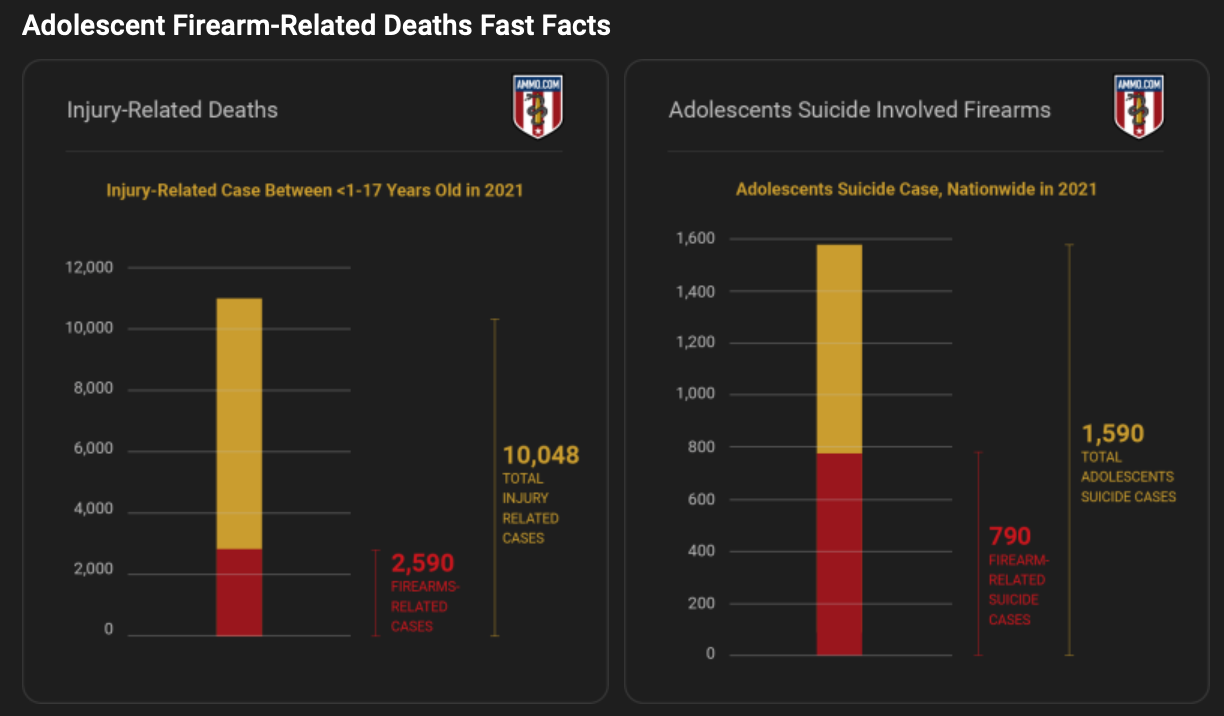
Join the conversation!